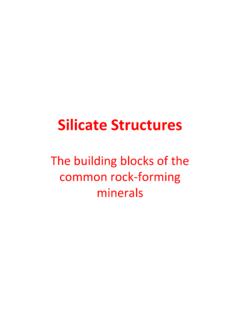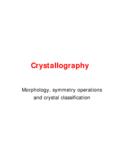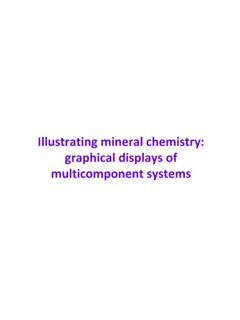Transcription of CHEMICAL ANALYSIS OF MINERALS
1 CHEMICAL ANALYSIS OF MINERALSQ uantitative methodology in mineralogy and mineral physicsCHEMICAL ANALYSIS OF MINERALST hdiff ttfbthlit tid There are many different types of both qualitative and quantitative ANALYSIS availableto mineralogists and petrologists. specific techniques are chosen based on the goals of the researcher andthecharacteristicsofthesamplesbeingst udiedand the characteristics of the samples being studied. The four most important things to know before beginning any type of CHEMICAL ANALYSIS are:1) What are the specific elements that we are hoping or expecting to analyze?2)Whatarethecharacteristicsofthe seelements(i eatomic2) What are the characteristics of these elements ( atomic weight and atomic number)?3) What are the concentrations of the elements that we are dealingwith(weight%pptppmppb)?dealing with (weight %, ppt, ppm, ppb)?4) With which MINERALS or mineral phases are particular elements associated? This is especially important for in situ ANALYSIS where knowledgeofthephaseisafirstordercontrolo ntheset upoftheknowledge of the phase is a first order control on the setup of the analytical OF THE TYPES OF CHEMICAL ANALYSISB dldi idhilliitfti Broadly, we can divide CHEMICAL ANALYSIS into a few catagories:1) Wet CHEMICAL Analysis2)Powderorwetspectroscopy2) Powder or wet spectroscopy3) In situ spectroscopy Once again, depending on your goals, some methods of CHEMICAL ANALYSIS may be more appropriate than others; however, there is considerable overlap between all techniques.
2 Ingeneral,wetchemistryinvolvesdissolving amineralinanacidIn general, wet chemistry involves dissolving a mineral in an acid then analyzing the solution. Despite the variety of spectroscopic techniques, all involve some energysourcethatisusedtobombardasamplesi nordertoenergy source that is used to bombard a samples in order to produce an electromagnetic signal that can be detected and analyzed. CHEMICAL ANALYSIS of MineralsWET CHEMISTRYT hthbitfthithtf There are three basic types of wet chemistry; however, aspects of wet chemistry are utilized in the sample preparation for a number of spectroscopic ) Gravimetric2) Volumetric3)Colorimetric3) Colorimetric For the most part all of these techniques require mineral samples pqqpthat are relatively pure . These must then be powdered then dissolved once or over several steps. Mineral samples that are pure are often difficult to find in nature which may be problematic for these types of ANALYSIS of MineralsSPECTROSCOPIC TECHNIQUEST hlti ltftithith tb There are multiple types of spectroscopic techniques that can be used to study the characteristics of elements that compose MINERALS .
3 For the most part, all spectroscopic techniques take advantage of the same energy principals:1)Bybombardingasamplewithener gy,electronsand/or1) By bombarding a sample with energy, electrons and/or neutrons can be ) Electrons (and neutrons) can be made to change energy levels. Subsequently,theywillrelaxbacktotheirgro undstateandreleaseSubsequently, they will relax back to their ground state and release characteristic energy3) Detectors can be set up to look for specific characteristics of the electro magnetic spectrum:gpa) specific energiesb) specific wavelengthsChemical ANALYSIS of Mineralsc) specific frequenciesCK3 SPECTROSCOPIC TECHNIQUES: ICP & AASB thfththitkthltithi Both of these techniques take the sample preparation techniques of wet chemistry with some sort of reactive flux added as well. Dissolved samples are then sprayed into a chamber and heated to temperatures between ~1500 C and ~6600 C. Atomic absorption ANALYSIS (AAS) then uses a controlled flame andmonochrometerlinkedtoadetectortosearc hforwavelengthsand monochrometer linked to a detector to search for wavelengths of light that are absorbed by the flame.
4 Inductively coupled plasma (ICP) spectrometry uses a gas (typicallyArgon)tomovethesamplevaporinto achamberunder(typically Argon) to move the sample vapor into a chamber under high vacuum where both the sample and gas are heated such that elements will give off a characteristic wavelength of light. Both of these techniques require comparison to a set of known ANALYSIS of MineralsLaser ablation unitLaser ablation unitinductively coupled plasmainductively coupled plasma mass spectrometerChemical ANALYSIS of MineralsSPECTROSCOPIC TECHNIQUES: XRF & XRDXFl(XRF) it h ith t hbd X-ray Fluorescence (XRF) is a technique that has broad application to mineralogy and petrology as multiple elements/ oxides can be analyzed for ) High voltage accelerates electrons toward a metal target to produce a specific fixed wavelength x-ray beam that hits the sample2) Inner shell electrons in the sample are ejected and photons are emitted as outer shell electrons drop to inner ) Photons have characteristic energies and elemental concentrations can be calculated with this technique by comparing sample intensities to a know standard.
5 XRF can analyze most elements heavier than oxygen (though there can be some complicating factors) down to the ppm ANALYSIS of MineralsCK2 CHEMICAL ANALYSIS of MineralsSPECTROSCOPIC TECHNIQUES: XRF & XRD X ray Diffractometry (XRD) is a technique that is really only appropriately applied to pure amorphous or crystalline substances and allows the user to learn a great deal about the structure of the )Anx raybeamisfiredatasampleoveraseriesofangl esbut1) An xray beam is fired at a sample over a series of angles but keeping the source and target (sample) always at the same distance (called a goniometer).2)Thereflectedordiffractedx raysprovidea2 thetaanglesuch2) The reflected or diffracted xrays provide a 2theta angle such that Bragg s Law(n = 2d Sin Ф) can be solved and we can use the d spacing value to define the h, k, and l indices of the unit ) Using the three indices, we can calculate the dimensions of the )g,units cellChemical ANALYSIS of MineralsChemical ANALYSIS of MineralsChemical ANALYSIS of MineralsSPECTROSCOPIC TECHNIQUES: EPMA & SEMEl tbili(EPMA)bi Electron probe micro ANALYSIS (EPMA) basics1) A beam of electrons is generated and sent from the electron gun through a series of lenses and aperatures toward the target (specimen).
6 2) The diameter and strength of the beam can be modified based on the current and accelerating voltage used to generate the ) Electrons in the specimen are excited and then, as electrons relax and fall back from an excited to a ground state they will fluoresce and generate x rays4) X rays generated from the beam specimen interaction are characterized by energy and wavelength to identify the element, intensity is used to analyze concentrationA) Energy Dispersive Spectrometers (EDS): count number and energy of emitted x ray photonsB) Wavelength Dispersive Spectrometers (WDS): use )gpp()specifically tuned crystals to pick up particular wavelengths CHEMICAL ANALYSIS of MineralsElectron gunCathodeAnodeAlignment gcoilsLenses condenserscondensersObjective aperture assemblyobjectiveassemblyChemical ANALYSIS of MineralssampleM. Jercinovic, 2007d is known - solve for by changing Move crystal and detector to select different X-ray linesSi K SKCrystal monochromatorS K Cl K Ti K Ti K Gd L sampleProportional counterMaintain Bragg condition = motion of crystal and detector along CHEMICAL ANALYSIS of Mineralscircumference of circle (Rowland circle) M.
7 Jercinovic, 2007 SPECTROSCOPIC TECHNIQUES: EPMA & SEMSiEl tMi(SEM)bi Scanning Electron Microscopy (SEM) basics1) Very similar to EPMA in that an electron gun is used to generate and fire electrons in a beam at a ) SEM is generally considered only semi quantitative, but can produce incredible images using both secondary electron scatteror backscattered electrons(BSE).A) Secondary electron images can reveal a great deal about the topography of a )BSErevealcontrastsbasedonaverageatomicB ) BSE reveal contrasts based on average atomic number such that images will reveal higher rates of backscatter based the relative density of atoms composing the ) EDS spectrometers are most commonly used on SEM )pyequipment while microprobes often used both EDS and ANALYSIS of MineralsChemical ANALYSIS of MineralsChemical ANALYSIS of MineralsSPECTROSCOPIC TECHNIQUES: Sample tMi(SEM) Scanning Electron Microscopy (SEM) 1) SEM can be performed on thin sections as well as angular mineral grains as well as carbon based materials2) A conductive coat of platinum or gold is required on top of the specimen to mitigate charging issues when the sample is bombarded with electrons Electron probe microanalysis (EPMA)1) Sample prep for microprobe work requires a bit more effort.
8 Thinsectionsmustbemadeandgroundto~30 mthicknessthenpolishedThin sections must be made and ground to 30 m thickness then polished to a high gloss through a series (15 20) steps. 2) Samples must then be carbon coated and kept under vacuum being qualitatively or quantitatively analyzed. Both of these techniques are quite powerful in that samples do not have to be powdered or dissolved and the ANALYSIS is non ANALYSIS of MineralsSPECTROSCOPIC TECHNIQUES: Mass t Mass Spectrometry 1) Mass spectrometry ANALYSIS comes in a variety of forms. Some common types of mass spec are a) secondary ion mass spectrometry(SIMS), thermal ionization mass spectrometry(TIMS), and multicollector mass ) All these techniques are similar in that an ion beam is generated by a type of plasmatron or an alkali metal. The beam is then focused at a sample and used to erode and sputter the target area. This sputtered and ionized material is then carried into the spectrometer by a gas.
9 Mass spectrometry can be conducted in situ, on mineral separates, or dissolved specimen. Mass spec is also very good for analyzingextremelylightelements(i eHBeLi)becausetheionanalyzing extremely light elements ( H, Be, Li) because the ion beam is relatively low energy so light elements or things of very low abundance can still be counted; therefore, it is very useful for analysisofstableandradiogenicisotopes( ). ANALYSIS of stable and radiogenic isotopes ( age dating). CHEMICAL ANALYSIS of MineralsChemical ANALYSIS of MineralsSPECTROSCOPIC TECHNIQUES: PIGE & PIXE Photon Induced Emission Spectroscopy1)Broadlytherearetwotypesofp hotoninducedspectroscopy:1) Broadly, there are two types of photon induced spectroscopy: gamma rayand x ray2) As opposed to the other types of spectroscopy discussed previouslythistechniqueusesaprotonbeamat veryhighenergytopreviously, this technique uses a proton beam at very high energy to produce incredibly small, electro megnetically focused beams with little to no background interference )TogetherPIGEandPIXE cananalyzetheentirerangeof3) TogetherPIGEand PIXEcan analyze the entire range of elements by their characteristic x rays.
10 Despite the utility of these techniques, they have been somewhat limitedlyappliedbecausethepowerneedsrequ iretheuseofalimitedly applied because the power needs require the use of a nuclear ANALYSIS of MineralsChemical ANALYSIS of MineralsSPECTROSCOPIC TECHNIQUES: Neutron ActivationNtAti tiAli Neutron Activation Analysis1) There are a wide variety of types of neutron activation ANALYSIS . The different types of ANALYSIS are based on the half lives of the elements of ) All types of neutron activation ANALYSIS are based in the idea that any element can be made radioactive if it is bombarded with enough energy. A) In this type of spectroscopy, samples are placed in a nuclear reactor where they are targeted by neturons to generate a thermal ) Known standards are placed in the reactor along with the ) Both the sample and the unknown are removed from the reactor together. Immediately, both materials begin to decay and produce gamma radiation that can be counted and used as a proxy for ANALYSIS of MineralsSPECTROSCOPIC TECHNIQUES: Neutron ActivationNtAti tiAli(t ) Neutron Activation ANALYSIS (types)1) Prompt Gamma Ray(PGNAA): radioactive nuclides are counted in the reactor as the sample is irradiated.











